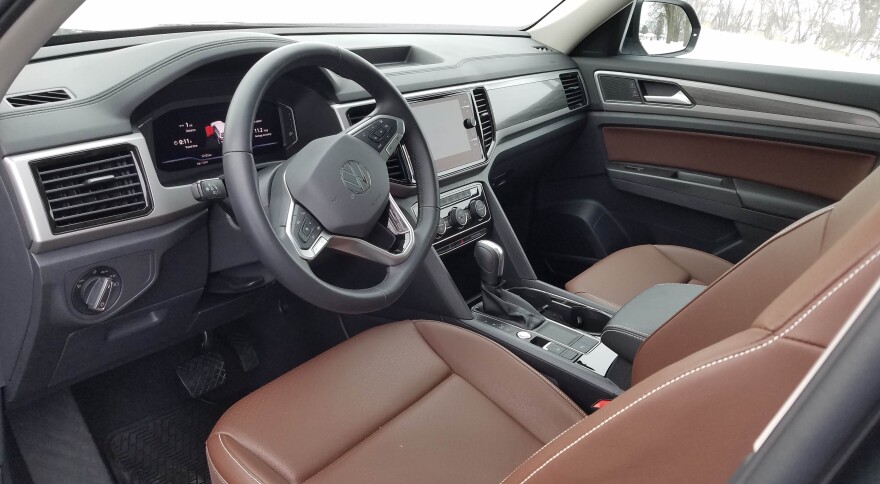Some vehicles stand out by not standing out. They are what I call Easy Riders, or maybe more appropriately Easy Drivers.
Such is Volkswagon’s restyled Atlas, the German firm’s mid-size crossover and one of its best-selling models in the U.S. market. VW restyled its nose and tail to give it more character. The grille is more pronounced and the body’s character lines make it look a bit more muscular with bulges high over the wheel wells.
READ: 2020 Volkswagen Passat SEL Review
The new look is more noteworthy than its original blandness, but still not something that will catch your attention at the drive-up window while you await your burger and fries.
No, it’s the little things that add up for Atlas, which actually touts a useable third row seat, a rarity even among large SUVs and crossovers.
First, VW added 2.4 inches to the crossover’s length that helps make an already roomy interior more so. Likewise VW upgraded the safety equipment so that now blind-spot alert, cross-traffic alert, forward collision warning and automatic braking are standard. Inside, the interior remains much the same, but now includes a flat-bottom steering wheel, oh, and there are 17 cup holders, especially handy if you’re trying to hydrate a soccer team.
My tester was a handsome dark Racing Green (looks almost black) SEL model, near the top of VW’s seven trim levels or 14 different models if you add the AWD versions of each. Yes, AWD is available on all trim levels now, including the entry-level S model that features a 2.0-liter 235-horse turbo four-cylinder engine. The SEL though features the smooth 3.6-liter V6 that churns 276 horses with a torque rating of 266.

This is where the easy driving begins. The V6 is quiet and works well with the 8-speed automatic transmission. There’s a slight hesitation in low gears, but generally you barely notice the shifts. Want quicker power, and be on notice there’s plenty of go power here, then tap the gearshift back to S (Sport) mode. Acceleration becomes speedier, so getting on the highway is a snap, and spinning the front wheels at stoplights is likely. I chirped the tires on this Atlas more than I have on many sport sedans.
Then there’s the ride, easily among the best I’ve experienced on a mid-size SUV or crossover. Downtown Milwaukee’s crumbling streets were well absorbed so as not to disturb occupants, one even saying he was impressed with the comfort. Likewise handling is good, more responsive than many crossovers and SUVs and with a lighter feel than a vehicle of this size, nearly 198 inches long, usually offers.
Being a Wisconsinite I’d opt for 4Motion, the $1,900 AWD system from VW. That would likely help give better traction once the streets become slippery. My test drive was in dry winter weather.
As impressive as the Atlas was to drive, I was happy to see that the dash was well laid out with a reasonable 8-inch infotainment screen and 10-inch digital driver gauge pod that is adjustable so you can see what YOU feel important, such as speed, fuel range, etc. Again, living in this interior is easy.
Is it flashy? No, it’s a German car, but not as dark as many. Seats are a medium brown to tan leatherette with white stitching while the dash is a textured dark brown. A gray fake wood trim spiffs up the dash and doors a bit too and the pewter look trim adds a bit of elegance. Gloss black surrounds the screen, stack controls and part of the console.

VW’s seats are well formed to provide good back and hip support, but are not overly snug. Front seats are powered and the driver gets three memory functions. The test Atlas featured the standard second row bench seat and split foldable third row seat so would seat seven. If you order second-row bucket seats then you’re Atlas is limited to six passengers.
As alluded to earlier, head and legroom are generous for the first two rows and good in row three. Usually third row seats make sardine tins look roomy. But there is reasonable legroom for adults here, a serious accomplishment by VW designers.
Yet still there is 20.6 cubic feet of cargo room behind the rear seat, better than many competitors, and 96.8 cubic feet when the two rear rows are folded flat. That’s massive.
Other bennies of the SEL are heated front seats and a heated steering wheel, both worked quickly. Plus the digital cockpit is standard along with a large panoramic sunroof and a wireless phone charger. Outside the SEL boasts 20-inch alloy wheels. VW also includes rear seat sun shades that one can pull up manually by the side door windows. That’s something usually found on much pricier vehicles.
Desire your car to be made in the U.S.? Well, the Atlas is assembled in Chattanooga, Tenn., so check that off your requirements list.
Naturally the rear hatch is powered and when equipped with a trailer hitch the Atlas will tow 5,000 lbs., not bad for a family hauler that’s this refined and comfortable.

Are there bugaboos to look out for? Certainly, but not many and some are the same of most crossovers of this size. First is the thick A-pillars that can spoil front side views. There’s a 360-degree camera here though, so that helps in parking lots.
But the Atlas roofline is a bit lower in front than some crossovers and SUVs, so for us shorter drivers an extra head duck is required for non-noggin-tagging entry. Why? Because the seat is further forward for us 5-6 and under drivers. Taller folks will never notice this.
I also had two other interior concerns, the floor heating, and an info screen issue. First, my right foot stayed warm, but my left foot was often cold and this was on mild Wisconsin winter days. I noticed that the plastic under the dash on that left side also is incredibly cold as I was driving, meaning there’s likely less sound-deadening material there, allowing cold to be transmitted into the area. I solved this by tucking my left foot behind my right while on the highway.
Then there’s the info screen, which includes navigation. It all works fine, but the radio must be on for the screen to be on and deliver its various functions, such as a map for navigating. You must turn the radio volume down if you want the screen on, but no chatter. GM vehicles are notorious for this, but most vehicles now allow the screen to function without the radio needing to be engaged.
Gas mileage also is modest. The EPA rates Atlas at 17 mpg city and 23 mpg highway, while I got 20.2 in a mix. By comparison two competitors, the Subaru Ascent and Hyundai Palisade are better at 20/26 for the Subie and 19/24 for the Hyundai. Again, this was without AWD on the VW.
But still, the ease of driving here and the comfortable roomy interior count for a lot of value in this market that also includes crossovers such as Honda’s Pilot, Ford’s Explorer, Kia’s Telluride and Toyota’s Highlander.
The tested SEL starts at $43,315 including delivery, and the tester added no options. In fact, options are minor with VW, which is why there are seven trim levels with FWD and AWD.
A base S with FWD lists at $31,345 and features cloth seats and 18-inch wheels and tires. The AWD model is $33,445. Next is the SE trim that adds a power driver’s seat, power hatch, leatherette seats and 1 USB port. It starts at $34,895 and may be the biggest bargain.
You can also add a tech package or go with the R-Line that looks more muscular outside and has unique trim, plus includes the tech package.
Next is the SEL I tested and then SEL R-Line or Premium, or Premium R-Line that tops out at $50,695.
In the SE and SEL trims the Atlas is one of the rare bargains that doesn’t look, or drive, like one!
Overview: 2021 Volkswagen Atlas SEL
Hits: Refreshed styling, good power and handling, excellent ride, plus roomy interior with usable third row seat. Panoramic sunroof, heated wheel and front seats, good safety equipment, plus flat-bottom wheel and wireless charger. Good value family hauler.
Misses: Big A-pillars with enough roof slant for difficult entry for shorter drivers who must duck heads or bump them. Cold left foot well for driver. MPG on low end.
Made In: Chattanooga, Tenn.
Engine: 3.6-liter V6, 276 hp
Transmission: 8-speed automatic
Weight: 4,425 lbs.
Wheelbase: 117.3 in.
Length: 197.6 in.
Cargo: 20.6-96.8 cu.ft.
Tow: 5,000 lbs.
MPG: 17/23, 20.2 (tested)
Base Price: $43,315 (includes delivery)
Invoice: $41,580
Major Options: None
Test Vehicle: $43,315
Source: VW, Kelley Blue Book
Editor's note: Mark Savage's auto review column, Savage On Wheels, looks at a new vehicle every week and tells consumers what’s good, what’s not so good, and how the vehicle fits into the marketplace.







